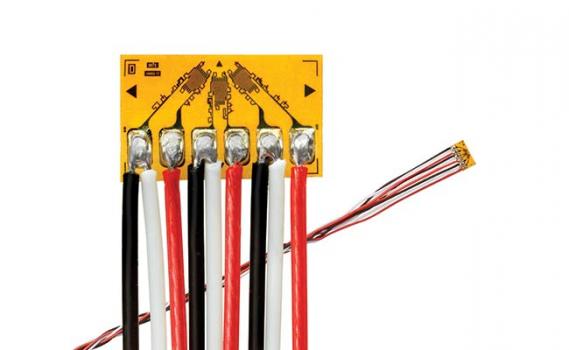PCB Testing Pattern Provides Precise Strain Detection

Description
Featuring Advanced Sensors Technology, the S5198 is a miniature rectangular planar rosette strain gage pattern for printed circuit board (PCB) testing.
Offered in two unique strain gage designations (C5K-XX-S5198-350/33F and C5K-XX-S5198-350/39F), the S5198 pattern provides precise strain detection with minimized non-uniform PCA strain gradient effects, along with reliable operation to +200°C. An industry best-in-class resistance specification of 350 Ω, as compared to the 120 Ω typical industry standard, reduces the unwanted self-heating and heat dissipation effects commonly found among substrates with poor heat conductivity, such as PCB’s. A reduced overall footprint, with grid length of just 0.36 millimeters, facilitates ease of target board placement and integration. The S5198 pattern is further supported by pre-attached high-performance Teflon insulated flexible thin cables, consisting of three twisted wires per grid. The wires are color coded, stripped and tinned for ease of PCB wire routing and connection to data acquisition systems.
In addition to PCB testing, the pattern is suitable for ball grid array (BGA) component testing, spherical bend testing, mechanical shock testing, PCB flexures, and in-circuit testing (ICT). The S5198 is RoHS compliant and is utilized in accordance with IPC–JEDEC 9702, IPC–JEDEC 9704, and JEDEC JESD22-B111 standards.
The Micro-Measurements Advanced Sensors Technology portfolio includes linear, shear and circular strain gages, in individual, half- and full-bridge configurations and in ranges from 350 Ω to 20 kΩ, with added flexibility in mounting options. Application of this VPG proprietary technology improves grid-to-grid tolerances and matching over traditional strain gage manufacturing techniques, enabling better sensor performance. In the case of full-bridge gage configurations, all intra-bridge connections are integrated directly into the pattern itself, eliminating the need for traditional intra-bridge soldering. The addition of gold-plated solder pads improves solder-joint reliability, while reducing the risks of solder pad oxidation prior to lead wire attachment. These processes further ensure the close matching of grid-to-grid thermal characteristics and bridge circuit thermal output cancellation specifications, both of which are essential to strain gauge measurement accuracy.
